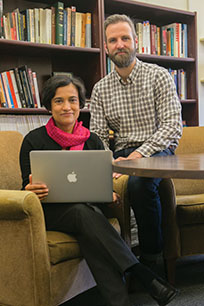Investigating Social Contagion With Digital Tools

Accumulating research provides evidence for a provocative idea that certain behaviors — such as smoking and eating habits — are contagious. Data suggest that we’re influenced not only by the behavior of our friends, family, and acquaintances, but also by the behavior of the people they know, and so on. How do these behaviors diffuse through a series of social connections? A rigorously controlled experiment is impossible on this scale — psychological scientists can’t exactly isolate an entire social network and manipulate the behavior of each of the specific members. But they can if they first represent the network using advanced computer models.
In a study recently published in Psychological Science, Past APS Board Member Suparna Rajaram and coauthor Christian Luhmann of Stony Brook University used this cutting-edge computer modeling to show how the memory of one individual can indirectly influence that of another via shared social connections.
“In large social networks, our model demonstrated that information is ‘contagious’ in much the same way that behavior seems to be contagious,” said Luhmann and Rajaram. “These results suggest that information transmission is a critical mechanism underlying the social transmission of behavior.”
While research has shown that various behaviors, including smoking, seem to spread throughout social networks, the mechanisms driving this behavioral contagion remain mysterious. To shed light on these contagious phenomena, Luhmann and Rajaram decided to incorporate well-established cognitive processes into computer models capable of simulating groups much larger than those typically seen in laboratory research. In doing so, they would be able to see how individuals interact, and how information flows, within groups that ranged from two to 500 people.
The researchers started by simulating information sharing in small three-person groups. Each simulated group member was programmed to be able to memorize information and learn from the other two members of the group, in accordance with prior findings derived from experiments with real people, to reflect actual memory-related processes.
The recall ability of the collaborative group was compared with the combined memory performance of three simulated individuals who studied and recalled words independently. In total, the researchers simulated 1,000 group-versus-individual comparisons.
The results directly mirrored patterns of information sharing and collective memory seen among real people. Specifically, the three-person groups were able to recall significantly fewer items than were the three individuals combined together, a phenomenon known as “collaborative inhibition.” The findings indicated that this occurs because individuals who learn together in groups tend to converge on similar information, limiting the overall amount of information that can be learned by the group.
Luhmann and Rajaram then expanded their investigation to examine collaborative groups of different sizes, from two to 128 members.
Again, the results echoed those found in small-scale experiments with real people. The researchers found that collaborative inhibition increased as the groups grew from two to seven members — each additional member improved the overall recall of collaborative groups, but the performance of these groups continued to lag behind that of the same number of individuals working in isolation.
The results suggest that the limitations on information sharing seen in small groups can’t be overcome by simply adding more members to the group. As group size increased beyond seven individuals, the collaborative groups starting catching up to the combined individuals, who had already achieved peak performance.
Next, to see how information would spread throughout a large group, Luhmann and Rajaram created a model that placed individuals into large, realistic networks and allowed them to interact with their “neighbors.”
As one might expect, direct neighbors showed more similar knowledge than did individuals who were indirectly linked through a shared neighbor.
However, the individuals who shared a neighbor but who never interacted with each other showed more similar knowledge than did those who were separated by two people in the network.
This suggests that a shared neighbor acts as a go-between, transmitting information to the individuals on either side and allowing them to indirectly influence each other. The researchers found that this indirect influence waned as the distance between two individuals grew, leveling off after six degrees of separation.
“We know that social influences on memory are complex, and yet our simplified model is sufficient to account for key findings from previous work, both within small groups and large social networks,” concluded Luhmann and Rajaram. “Taken together, the findings of the current study leverage laboratory results and explanations to develop a much-needed theoretical account of behavior in large social networks.”
The researchers believe that these findings could shed light on the mechanisms that drive real-world contagious phenomena, including smoking, obesity, eyewitness testimony, and even fads and fashion.
References
Luhman, C. C., & Rajaram, S. (2015). Memory transmission in small groups and large networks: An agent-based model. Psychological Science, 26, 1909–1917. doi:10.1177/0956797615605798.





APS regularly opens certain online articles for discussion on our website. Effective February 2021, you must be a logged-in APS member to post comments. By posting a comment, you agree to our Community Guidelines and the display of your profile information, including your name and affiliation. Any opinions, findings, conclusions, or recommendations present in article comments are those of the writers and do not necessarily reflect the views of APS or the article’s author. For more information, please see our Community Guidelines.
Please login with your APS account to comment.